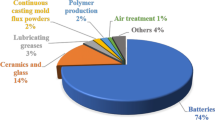Abstract
Acid leaching of uranium deposits is not a selective process. Sulfuric acid solubilizes iron(III) and half or more of the thorium depending on the mineralog of this element. In uranium recovery by solvent extraction process, uranium is separated from iron by an organic phase consisting of 10 vol% tributylphosphate(TBP) in kerosine diluent. Provided that the aqueous phase is saturated with ammonium nitrate or made 4–5 M in nitric acid prior to extraction. Nitric acid or ammonium nitrate is added to the leach solution in order to obtain a uranyl nitrate product. Leach solutions containing thorium(IV) besides iron are treated in an analogous fashion. Uranium can be extracted away from thorium using 10 vol% TBP in kerosine diluent. The aqueous phase should be saturated with ammonium nitrate and the pH of the solution lowered to 0.5 with sufficient amount of sulfuric acid. In other words, the separation of uranium and thorium depends on the way the relative distributions of the two materials between aqueous solutions and TBP vary with sulfuric acid concentration. Thorium is later recovered from the waste leach liquor, after removal of sulfate ions. Uranium can be stripped from the organic phase by distilled water, and precipitated as ammonium diuranate.
Similar content being viewed by others
References
H. A. C. McKAY, Proc. Intern. Conf. on the Peaceful Uses of Atomic Energy, Vol. 7, United Nations, New York, 1956, p. 314.
R. C. MERRITTE, The Extractive Metallurgy of Uranium, US Atomic Energy Commission, 1971, p. 221.
Joint report by the OECD Nuclear Energy Agency and the International Atomic Energy Agency on uranium extraction technology, Paris, 1983.
C. J. RODDEN, N. H. FURMAN, L. L. QUIL, E. H. HUFFMAN, T. D. PRICE, J. I. WTERS, Analytical Chemistry of the Manhattan Project, US Atomic Energy Commission, 1950, p. 419.
P. T. CHIANG, US Patent Doc. 4/255/392/A, Inst. C122B 60/02, 1981.
S. M. GOLDBERG, M. BENEDICT, H. W. LEVI, Nucl. Sci. Eng., 47 (1972) 169.
W. MARSHALL, Nuclear Power Technology, Vol. 2, Clarendon Press, Oxford, 1983, p. 398.
E. K. HYDE, Proc. Intern. Conf. on the Peaceful Uses of Atomic Energy, Vol. 7, United Nations, New York, 1956, p. 281.
G. H. MORRISON, H. FREISER, Solvent Extraction in Analytical Chemistry, Wiley, New York, 1965, p. 137.
Author information
Authors and Affiliations
Rights and permissions
About this article
Cite this article
Movaseghi, H. Method of separating uranium from iron and thorium. Journal of Radioanalytical and Nuclear Chemistry, Articles 99, 331–335 (1986). https://doi.org/10.1007/BF02037593
Received:
Issue Date:
DOI: https://doi.org/10.1007/BF02037593




